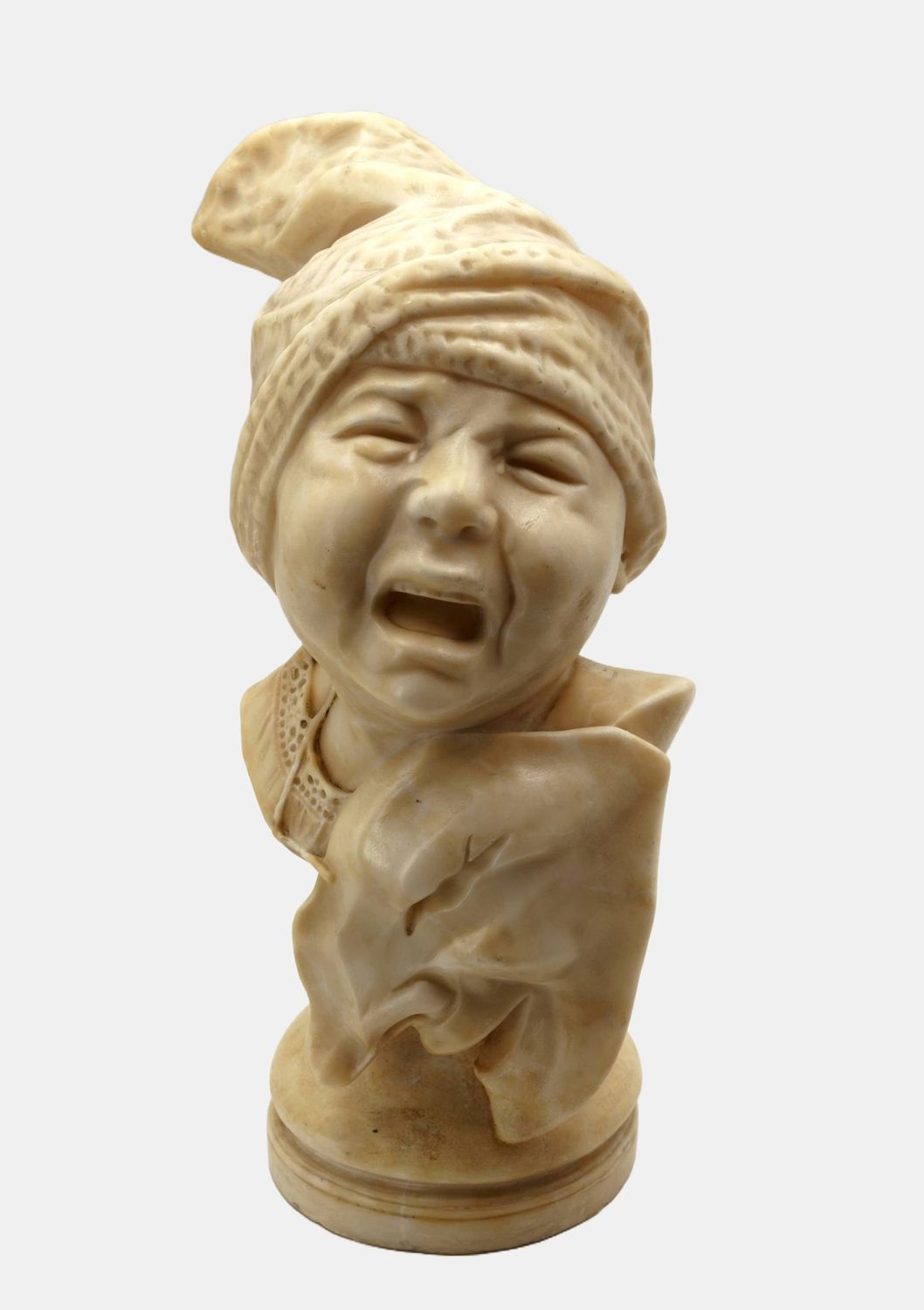Lambeaux, Jef (1852-1908), Weeping Boy with Laughing Mask, c. 1890
Jef(Joseph Marie Thomas) Lambeaux(1852 Antwerp - 1908 Brussels), Weeping boy with laughing mask , around 1890. Alabaster on a round base (8 cm high), total height 37 cm, width 22 cm, depth 18 cm, weight 9 kg. With incised signature “JeF.LAMBEAUX” on the reverse.
- Slightly dented in places, the cord of the cap with a small loss in one place, otherwise in very good condition.
- The tragicomedy -
During the Baroque era, artists such as Peter Paul Rubens and Gian Lorenzo Bernini explored human passions. The emotions depicted also included humor, which could easily erupt into uproarious laughter. In his work, Jef Lambeaux takes these Baroque pictorial forces and transposes them into his own time.
The boy's crying has intensified to the point of screaming. Tears roll from his eyes and trickle down his cheeks, his mouth is open, and his entire face, especially his forehead, is contorted with emotion. As Gotthold Ephraim Lessing points out in his essay "Laokoon or on the Limits of Painting and Poetry" (1766), it is absolutely impossible to make an emotion the main subject of representation, because the extraordinary emotional state fades away in reality, while it remains permanently present in the painting, which has a highly unpleasant effect on the viewer. And yet Lambeaux succeeds in this balancing act. He masterfully models the expression of pain from the child's physiognomy, while at the same time giving the boy a putto-like quality that removes him from reality.
In the Baroque period, putti were used to illustrate emotions and the senses. Lambeaux draws on this, giving the boy an allegorical dimension. However, the bust does not only illustrate grief heightened to pain; beneath the childlike putto is a laughing mask with an oversized nose. It seems to be laughing at the top of its lungs and represents the physiognomic counterpart to the boy's face. As a mask, it refers to theater and comedy, and thus to life itself, as the master of realism, Honoré de Balzac, called his monumental 137-volume work "The Human Comedy". Taken together, the laughing mask and the crying boy represent the tragicomedy of humanity, with the mask seeming to laugh maliciously at the boy's real pain, as if it knows that crying does not change the tragedy.
About the artist
Jef Lambeaux entered the Antwerp Academy of Fine Arts at the age of ten. He initially studied under Nicaise de Keyser and from 1871 under Joseph Geefs. At the age of just fourteen he received two academy prizes and from 1871 he began to exhibit in the Belgian salons, initially in Antwerp and later also in Ghent and Brussels.
From 1879 to 1881, Lambeaux lived in Paris, where he shared a studio with the painters Jan van Beers and Gustave Vanaise. Back in Brussels, he worked for the Castan Waxworks to earn a living. However, he was commissioned to make two caryatids for the interior of Antwerp City Hall, so that he could devote himself entirely to art again. During this time, he created his first widely acclaimed work, “The Kiss”. A scholarship enabled him to spend time in Italy in 1882/83, where he was impressed by Giambologna's oeuvre, in particular the “Rape of the Sabine Women” (1583).
Back in Brussels, he made contact with the avant-garde - as he had done during his time in Paris - and became a founding member of the progressive artists' group “Les XX”, which also included Fernand Khnopff, Théo van Rysselberghe and James Ensor. After a year, however, he left the group again, as Lambeaux was primarily interested in revitalizing Baroque pictorial forces, while the emerging Modernism was moving along different paths. In his work, inspired in particular by Peter Paul Rubens, Giambologna and Gian Lorenzo Bernini, Lambeaux repeatedly took up the violence of Eros, which ultimately led to his main work “The Human Passions”, created between 1890 and 1900. A seven-meter-wide high relief commissioned by King Leopold II after he had seen the designs at the Ghent Salon in 1899. Victor Horta built a temple-like pavilion for the relief in the Parc du Cinquantenaire in Brussels, where the work can still be seen today.
Lambeaux was admitted to the Légion d'honneur for his work “Drunkenness”, which was shown at the Paris Salon in 1894. One year after his death, in 1909, the city of Amsterdam honored him with a retrospective.

